
The Franklin Pierce Homestead is a historic house museum and state park located in Hillsborough, New Hampshire. It was the childhood home of the fourteenth President of the United States, Franklin Pierce.

Blackacre State Nature Preserve is a 271-acre (110 ha) nature preserve and historic homestead in Louisville, Kentucky. The preserve features rolling fields, streams, forests, and a homestead dating back to the 18th century. For visitors, the preserve features several farm animals including horses, goats, and cows, hiking trails, and a visitor's center in the 1844-built Presley Tyler home. Since 1981, it has been used by the Jefferson County Public Schools as the site of a continuing environmental education program. About 10,000 students visit the outdoor classroom each year.

The Joseph F. Glidden House is located in the United States in the DeKalb County, Illinois city of DeKalb. It was the home to the famed inventor of barbed wire Joseph Glidden. The barn, still located on the property near several commercial buildings, is said to be where Glidden perfected his improved version of barbed wire which would eventually transform him into a successful entrepreneur. The Glidden House was added to the National Register of Historic Places in 1973. The home was designed by another barbed wire patent holder in DeKalb, Jacob Haish.

The Arnold Homestead is a historic homestead in the city of Huber Heights, a suburb of Dayton, Ohio, United States. Formed at the turn of the nineteenth century, it centers on an 1830s farmhouse that was built for an immigrant family from Virginia.

Homeplace Plantation House, also known as Keller Homestead, is a National Historic Landmark on Louisiana Highway 18 in Hahnville, St. Charles Parish, Louisiana. Built 1787-91, it is one of the nation's finest examples of a French colonial raised cottage. It was declared a National Historic Landmark in 1970 for its architecture. It is private property, and is not open to the public.
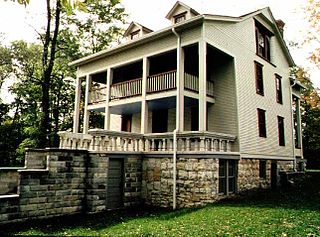
The Joseph Bailly Homestead, also known as Joseph Bailly Homestead and Cemetery, in Porter, Indiana, is a U.S. National Historic Landmark.

Portage Point Inn Complex is a resort hotel located at the western end of Portage Lake at Portage Point, Michigan. In October 1985, this 1902 resort hotel and its associated buildings was added to the National Register of Historic Places. It operates today as the Portage Point Resort.
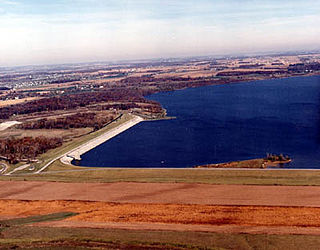
Buck Creek State Park is a 4,016-acre (1,625 ha) Ohio state park in Clark County, Ohio in the United States, around part of Buck Creek. The park is leased by the state of Ohio from the U.S. Army Corps of Engineers. It includes C. J. Brown Reservoir and Dam, a flood control dam and reservoir built by the USACE as part of a flood control system in the Ohio River drainage basin. Buck Creek State Park is open for year-round recreation including camping, boating, hunting, fishing, swimming, picnicking and hiking.

The Warren Sweetser House is a historic house at 90 Franklin Street in Stoneham, Massachusetts. It is one of the finest Greek Revival houses in Stoneham, recognized as much for its elaborate interior detailing as it is for its exterior features. Originally located at 434 Main Street, it was moved to its present location in 2003 after being threatened with demolition. The house was found to be eligible for listing on the National Register of Historic Places in 1984, but was not listed due to owner objection. In 1990 it was listed as a contributing resource to the Central Square Historic District at its old location. It was listed on its own at its new location in 2005.

Cumberland Homesteads is a community located in Cumberland County, Tennessee, United States. Established by the New Deal-era Division of Subsistence Homesteads in 1934, the community was envisioned by federal planners as a model of cooperative living for the region's distressed farmers, coal miners, and factory workers. While the cooperative experiment failed and the federal government withdrew from the project in the 1940s, the Homesteads community nevertheless survived. In 1988, several hundred of the community's original houses and other buildings, which are characterized by the native "crab orchard" sandstone used in their construction, were added to the National Register of Historic Places as a historic district.
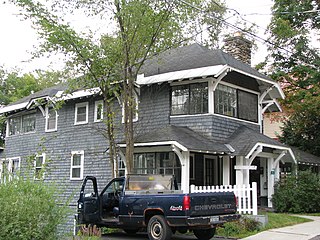
Hill Cottage is a historic cure cottage located at Saranac Lake, town of Harrietstown in Essex and Franklin County, New York. It was built about 1913 and is a two to four story, shingled frame house on a stone foundation, with a jerkinhead gable roof and built into the side of a hill. It features an open first floor porch and second story cure porch on the front facade, four stories of cure porches in the rear, and prominent roof overhangs. It is in the American Craftsman style and designed specifically for use as a private sanatorium.

Distin Cottage is a historic cure cottage located at Saranac Lake in the town of Harrietstown, Franklin County, New York. It was built about 1920 and is a two-story, "L" shaped wood frame single-family dwelling with Colonial Revival style details. It has a hipped roof with a clipped gable and dormers. It features a cure porch measuring 8 feet by 10 feet. It was designed by architect William G. Distin for his father, photographer William L. Distin.
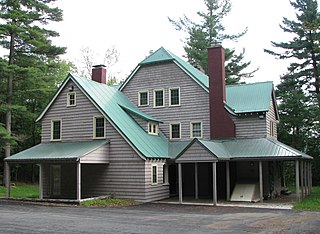
Larom-Welles Cottage is a historic cure cottage located at Saranac Lake in the town of North Elba, Essex and Franklin County, New York. It was built about 1905 and is a three-story wood frame structure in the Shingle Style on a stone foundation and surmounted by a metal jerkin head gable roof. It has a two-story wing with a shed roof dormer. It has a two bay verandah and entrance porch with a second story sleeping porch. Also on the second floor is a cure porch. It was originally built for the priest of St. Lukes Episcopal Church, later the home of Dr. Edward Welles, a pioneer in thoracic surgery, who practiced at the Adirondack Cottage Sanitarium. The house has been converted to six units.

Radwell Cottage is a historic cure cottage located at Saranac Lake in the town of Harrietstown, Franklin County, New York. It was built about 1896 and is a 2 1⁄2-story, wood frame dwelling with clapboard siding and a gable roof on a native fieldstone foundation. It features a flat-roofed cure porch in an irregular "L" shape that bends outward from the facade. A second cure porch is rectangular and supported on posts.

The Johns Hotel (20IR64) is a complex of buildings, of which but two remain, located near Washington Harbor, on Barnum Island, Isle Royale National Park, Michigan. It was listed on the National Register of Historic Places in 1997.
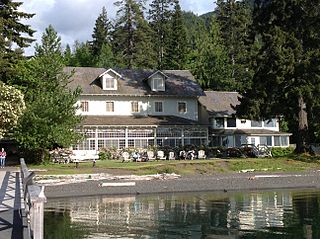
Lake Crescent Lodge, originally called Singer's Lake Crescent Tavern, is a historic resort situated on the shores of Lake Crescent west of Port Angeles, Washington. Located on the Olympic Peninsula within Olympic National Park, the Lodge is owned by the National Park Service and operated by Aramark. The Lodge resort is open seasonally from early May until the end of January with select cabins available during the winter months. Hiking and boating are popular activities for guests, and several peaks, including Mount Storm King and Pyramid Mountain, are easily accessible from the resort. Other hiking opportunities include Marymere Falls, Spruce Railroad, and Barnes Creek Trails.

Causeyville, Mississippi is a small community in southeastern Lauderdale County, Mississippi, about twelve miles southeast of the city of Meridian. The Causeyville Historic District consists of four buildings at the center of the community–two general stores and two residences–that exemplify the pivotal contribution that small communities like Causeyville made to the development of Lauderdale County. The district was added to the National Register of Historic Places in 1986.
Lacy Homestead, also known as the William Austin Lacy House, is one of the only surviving remnants of a settlement in northern Lauderdale County, Mississippi known as "Little Georgia". The first settlers of this area came from Jackson County, Georgia and areas of Virginia, bringing their customs and architectural styles with them to the area. The homestead was listed on the National Register of Historic Places in 2007.

The Breakwater is a historic sporting lodge on the Mount Kineo peninsula of Moosehead Lake in central Maine. Built in 1909, it is an architecturally sophisticated example of a sporting lodge, exhibiting Shingle style and Italianate features. It was designed by Howard G. Chamberlain, a New York City architect, with funding from the nearby Mount Kineo Resort and the Moosehead Yacht Club. It was one of the centerpieces of central Maine's most successful summer resort, and was listed on the National Register of Historic Places in 2002.
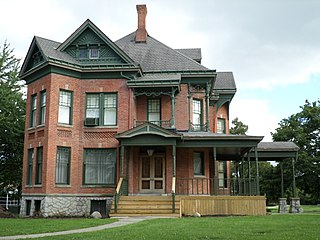
The Superintendent's Cottage at the Michigan School for the Deaf is a single-family home located on Beaver Drive, on the Michigan School for the Deaf campus, in Flint, Michigan, It was listed on the National Register of Historic Places in 1975.


























